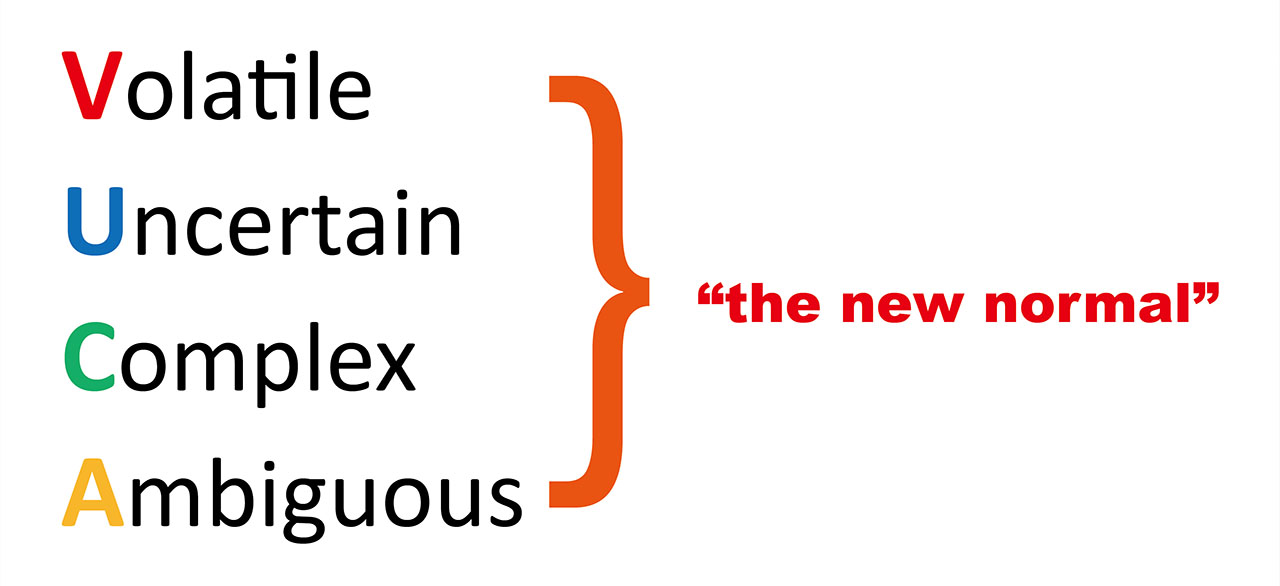In today’s highly disruptive and digital-driven world, organizations continue to be impacted by a multitude of changes and it influences the way they operate. With increasing volatility in the markets, ever-changing customer needs, and continuous technology-led disruptions to business models, an organization’s agility is what can help it wither the storm of changes that hit it every day.
On the other hand, the complexity and disruptions in the business environment today continuously decrease the visibility of businesses beyond a quarter, impeding organizations’ ability to build long-term plans and requiring them to reinvent continually.
The four elements of VUCA (see Figure 1) describe the “fog of war”—the chaotic conditions that are encountered on a modern battlefield. Its relevance to leaders in business is clear, as these conditions are highly descriptive of the environment in which business is conducted every day (Bawany 2019).

Figure 1: The “V.U.C.A.” Framework
Leaders would need to understand the following implications of the characteristics of VUCA on their organization and its relevance to today’s workplace is clear, as these conditions are highly descriptive of the environment in which business is conducted every day.
Volatility
What is it? Volatility refers to the rate of change of information and the pace of change in the situation. Things can change unpredictably, suddenly, and incredibly, especially for the worse. There is a brutal increase in four dimensions of changes we face today: type, speed, volume, and impact. Given the lack of predictability in issues and events, these volatile times make it difficult for leaders to use experience and events as predictors of future outcomes, making forecasting extremely difficult and decision-making a real challenge (Bawany 2020).
A rapidly changing environment calls for adaptive and innovative decision-making. Power and wealth set the stage for competition over finite resources. Both nature and how businesses compete in the marketplace change rapidly, driven on the “hard” side by technology and the “soft” side by increasingly easy communication. Some change seems short-term and explosive, but often that is because it was unanticipated. Challenges faced are unexpected and most likely of unknown duration.
Uncertainty
What is it? Uncertainty is a result of volatility as we are unable to predict future events. Important information is not known or definite; doubtful, unclear about the present situation and future outcomes; and not able to be relied upon. The uncertainty stems from the inability to know everything about the current situation and the difficulty of predicting what the effects of a proposed change today will be in the future. It can also arise because decision-makers do not have proper “intelligence”-gathering operations, including competitors or market intelligence. It can result in deception where competitors seek to gain an advantage by surprising the organization with their pre-empted marketing actions (Bawany 2020).
information, big data analytics, and knowledge management systems and this works best in conjunction with structural changes allowing organizations to reduce uncertainty. With uncertainty, strategic leaders must be willing to take measured and prudent risks, be able to assess risk accurately and develop risk management strategies.
Complexity
What is it? Complexity differs from uncertainty, though its effects may sometimes be similar. There are many different and connected parts, such as multiple key decision factors, the interaction between diverse agents, emergence, adaptation, coevolution, and weak signals. There are often numerous and difficult-to-understand causes and mitigating factors (both inside and outside the organization) involved in a problem (Bawany 2020).
Many situations consist of various interconnected parts and variables. Being well informed of all these different parts can be extremely overwhelming and often technical too. This layer of complexity, added to the turbulence of change and the absence of past predictors, adds to the difficulty of decision-making. It also leads to confusion, which can cause ambiguity, the last letter in the acronym of VUCA.
Ambiguity
What is it? Ambiguity exists when a decision-maker does not understand the significance of a given event or situation—doesn’t know what is happening. The situation could be open to more than one interpretation; the meaning of an event can be understood in different ways. Casual relationships are utterly unclear as no precedent exists, forcing the leader to face unknown factors. It can occur when leaders do not have the right mental models and breakthrough mindsets, thereby observing events that “don’t make sense”.
Ambiguity can also happen when an event or situation can legitimately be interpreted in more than one way. Vulnerability to misinterpretation of events in complex cases is high when decisions are centralized, decision pressure is high, the decision maker is powerful, and the decision maker acts alone. As a result, this would be a recipe for disaster.
Conclusion
We are operating in a hypercompetitive, disruptive, digital, and VUCA-driven business environment. The world moves faster today when compared to 20 to 30 years ago. Businesses feel the pressure to decrease time to market and improve the quality of products while delivering on ever-changing customer expectations to maintain competitive posture, that is, be adaptive and agile. Driving and achieving sustainable results in this new normal is incredibly challenging even for organizations that have the benefit of leveraging upon dedicated and knowledgeable employees and business leaders.
Today, research by the Centre for Executive Education (CEE), the Disruptive Leadership Institute (DLI), and the Executive Development Associates (EDA) has shown that disruptive leaders need to demonstrate a suite of leadership competencies including cognitive readiness (critical and strategic thinking skills), emotional and social intelligence, resilience, managerial coaching, and leading team for performance among others effectively, in driving results and achieving success in a high-performance organization.

